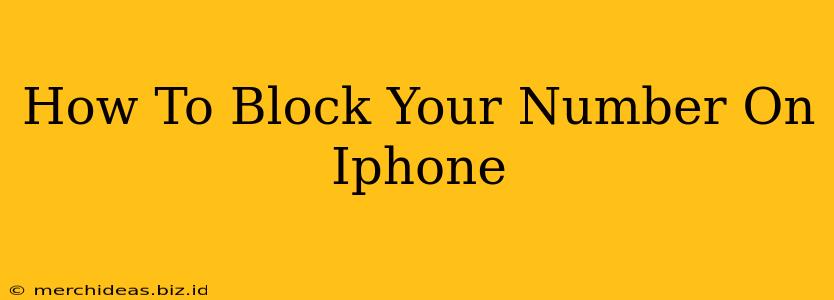Are you looking to make calls without revealing your real phone number? Want to maintain your privacy while using your iPhone? Blocking your number, often referred to as making a private call, is a simple process. This guide will walk you through several methods to effectively block your number on your iPhone, ensuring your calls remain anonymous. Let's dive in!
Understanding Number Blocking on iPhone
Before we begin, it's important to understand that blocking your number doesn't offer complete anonymity. While it prevents the recipient from seeing your actual phone number, your carrier may still be able to track the call. Furthermore, some phone systems or services might still identify the call's origin.
Key Differences:
- Complete Anonymity: This isn't truly achievable without specialized equipment.
- Privacy for General Calls: This is the most common use case, offering a level of privacy for everyday calls.
- Specific App Limitations: Certain apps might override your number-blocking settings.
Methods to Block Your Number on iPhone
There are several ways to block your number on your iPhone, depending on your specific needs and whether you're making a single private call or want to consistently hide your number:
1. Blocking Your Number for a Single Call
This is the simplest method. It's perfect for one-off calls where you don't want your number displayed.
- *Dialing the 67 Prefix: Before dialing the number you wish to call, simply enter
*67followed by the phone number. For example:*67 555-123-4567. This will temporarily block your number for that single call. Remember, this is a temporary solution and won't persist for future calls.
2. Enabling "Hide My Number" in Settings (for all calls):
This option enables caller ID blocking for all outgoing calls from your iPhone until you disable it. This is useful for consistently making private calls.
- Access Settings: Open the "Settings" app on your iPhone.
- Locate Phone: Tap on "Phone".
- Enable "Show My Caller ID": Locate and toggle off the "Show My Caller ID" option. You'll typically see a slider switch; simply slide it to the left to disable the feature.
Important Considerations:
- Carrier Support: Not all carriers support this function universally. If you encounter issues, contact your carrier to check for compatibility.
- Emergency Services: Remember that emergency services might still receive your number, even with this setting enabled.
Troubleshooting and FAQs
Q: Why isn't my number being blocked?
- Carrier Restrictions: Your carrier might not support number blocking for all calls.
- App Interference: Certain apps might override your phone's settings, specifically VoIP apps or third-party dialer apps.
- Incorrect Procedure: Double-check the steps you followed, ensuring you've correctly entered the *67 prefix or disabled "Show My Caller ID".
Q: Does hiding my number affect call receiving?
No, disabling "Show My Caller ID" only affects outgoing calls; your ability to receive calls remains unchanged.
Q: Is this completely anonymous?
No, your call can often be traced back to you by your carrier. Complete anonymity requires more advanced methods.
Conclusion
Blocking your number on your iPhone provides a convenient way to protect your privacy for everyday calls. Whether you choose to use the *67 prefix for single calls or disable "Show My Caller ID" for consistent blocking, understanding these methods empowers you to control your caller ID. Remember to always consider the limitations of caller ID blocking, and check with your carrier for any specific restrictions.
